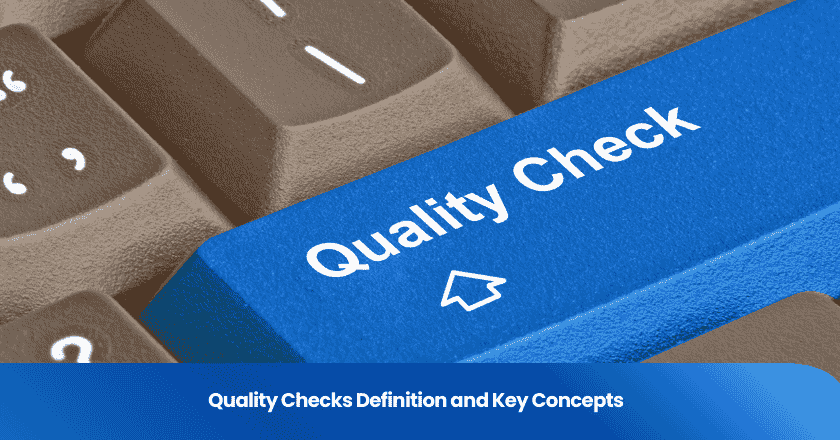
Quality checks refer to systematic processes that organizations use to examine products or services. These checks help ensure that all outputs meet established quality standards. Companies rely on quality checks to maintain consistency and avoid defects. High-quality results build trust with customers and support business goals. Every industry, from manufacturing to healthcare, uses quality checks as part of its daily operations. Many professionals also include qa practices to guarantee reliable performance.
What Are Quality Checks?
Definition
Quality checks represent a set of systematic activities that organizations perform to evaluate whether products or services meet established quality requirements. These activities form a core part of qa processes. The quality control definition describes quality checks as procedures that help identify defects, inconsistencies, or deviations from expected standards. In practice, teams use quality checks to compare actual outcomes with predefined criteria. This approach ensures that every output aligns with customer expectations and regulatory guidelines.
Quality checks serve as a foundation for quality management systems. They support the broader concept of qa by providing measurable ways to assess performance. The quality control meaning centers on the idea of monitoring and verifying that all aspects of production or service delivery adhere to quality requirements. By following these procedures, organizations can detect issues early and prevent defective products from reaching customers.
Note: Quality checks are not limited to manufacturing. Service industries, healthcare, and technology sectors also rely on these checks to maintain high standards.
Purpose
The main goal of quality checks is to guarantee that products or services fulfill all quality requirements before reaching the customer. These checks act as a safeguard, ensuring that only items meeting strict criteria proceed to the next stage. Teams use qa methods to monitor processes, identify potential problems, and implement corrective actions when necessary.
Quality checks play a vital role in building customer trust. When organizations consistently deliver high-quality results, they strengthen their reputation and foster long-term relationships. Effective qa practices also help reduce costs by minimizing waste and rework. In regulated industries, quality checks ensure compliance with legal and safety standards.
Key purposes of quality checks include:
1. Verifying that outputs meet quality requirements.
2. Detecting and correcting defects early in the process.
3. Supporting continuous improvement through regular feedback.
4. Enhancing customer satisfaction by delivering reliable products and services.
5. Ensuring compliance with industry regulations and standards.
Quality checks, as part of a comprehensive qa strategy, help organizations achieve operational excellence. They provide a structured approach to maintaining quality at every stage of production or service delivery.
Key Concepts
Types of Quality Checks
Organizations use several types of quality checks to maintain high standards. Each type serves a unique purpose in the qa process. The most common types include:
- Pre-production checks: Teams perform these checks before production begins. They verify that materials and equipment meet quality requirements.
- In-process checks: Staff conduct these checks during production. They monitor processes to ensure consistency and detect defects early.
- Final inspection: Inspectors examine finished products or services. They compare results against established criteria to confirm quality.
- Random sampling: Teams select random items for inspection. This method helps identify hidden issues and supports quality control.
- Quality audit: Auditors review procedures and records. They assess compliance with quality management standards.
Tip: Combining different types of quality checks strengthens overall quality management and reduces the risk of errors.
Role in Quality Management
Quality checks play a central role in quality management systems. They support both quality control and quality assurance activities. Teams use qa methods to monitor production, service delivery, and compliance. Quality management relies on regular inspection and feedback to drive improvement.
| Quality Management Element | Role of Quality Checks |
|---|---|
| Quality control | Detects defects and ensures outputs meet standards |
| Quality assurance | Verifies processes and prevents issues before they occur |
| Inspection | Confirms product or service quality at each stage |
| Quality audit | Evaluates effectiveness of quality management systems |
Quality checks help organizations achieve consistent results. They provide data for decision-making and support continuous improvement. Effective qa practices build trust with customers and ensure compliance with regulations. Teams that prioritize quality management create reliable products and services.
Quality Assurance and Control
Quality Assurance
Quality assurance forms the backbone of any qa system. Teams design the quality assurance process to prevent defects before they occur. They focus on improving methods, training staff, and setting clear standards. The quality assurance process includes developing procedures, documenting workflows, and monitoring compliance. For example, in a hospital, staff follow strict protocols to ensure patient safety. The quality assurance team reviews these protocols regularly. They use a quality inspection checklist to verify that every step meets the required standards. This proactive approach helps organizations maintain high quality and reduce errors.
Note: Quality assurance emphasizes prevention rather than detection. Teams aim to build quality into every stage of production or service delivery.
Quality Control
Quality control operates as a reactive measure within qa. Staff use the quality control checklist to identify and correct defects after production. They inspect finished products or completed services to ensure they meet specifications. For instance, in a food processing plant, workers check packaged goods for proper labeling and freshness. The quality control team uses a quality inspection checklist to record findings and address issues. Quality control relies on testing, measurement, and corrective action. The goal is to catch problems before products reach customers.
| Aspect | Quality Assurance | Quality Control |
|---|---|---|
| Focus | Process improvement | Product inspection |
| Timing | Before production | After production |
| Tools | Quality inspection checklist | Quality control checklist |
Inspection
Inspection serves as a critical step in both quality assurance and quality control. Teams use inspection to compare actual outcomes with established criteria. They rely on a quality inspection checklist to guide their evaluations. In construction, inspectors review building materials and workmanship. They document results and recommend improvements. Inspection provides objective data for decision-making. It supports the qa process by confirming that standards are met at every stage.
Tip: Regular inspection using a quality inspection checklist strengthens both quality assurance and quality control efforts.
Performing Quality Checks
Methods
Organizations use several methods to perform quality checks. Teams often start with visual inspection. They look for obvious defects or inconsistencies in products or services. Staff may use a quality inspection checklist to guide this process. This checklist helps ensure that every step receives attention.
Measurement and testing represent another common method. Workers use tools to measure dimensions, weight, or other properties. They compare results to established standards. Sampling allows teams to inspect a portion of items from a batch. This approach saves time while still providing reliable data.
Automated inspection systems have become popular in many industries. Machines use cameras and sensors to detect defects quickly. These systems support qa by increasing accuracy and speed. In service industries, teams may use surveys or audits to evaluate performance. Each method supports the overall goal of maintaining high quality.
Tip: Combining multiple inspection methods often leads to better results and fewer errors.
Best Practices
Effective quality checks require careful planning and execution. Teams should always use a quality inspection checklist. This tool ensures that no step gets missed during inspection. Staff must receive training on qa procedures and quality assurance methods. Well-trained employees can spot issues early and take corrective action.
Regular calibration of inspection tools helps maintain accuracy. Teams should document every inspection result. This record supports continuous improvement and helps identify trends. Communication between departments also plays a key role. Sharing inspection findings allows for quick problem-solving.
Industry-specific considerations matter. For example, food processing plants must follow strict hygiene standards during inspection. Healthcare providers need to check equipment and procedures for patient safety. Each industry adapts qa practices to fit its unique needs.
Note: Consistent use of best practices in qa leads to higher quality and greater customer satisfaction.
Quality checks remain essential for organizations that seek consistent results and high standards. They help teams identify issues early and deliver reliable products or services. By focusing on quality, companies improve customer satisfaction and build trust. Regular evaluation and adaptation of quality processes also drive continuous improvement. Teams that prioritize quality checks see long-term gains in efficiency and customer satisfaction.
FAQ
What is the difference between quality assurance and quality control?
Quality assurance focuses on preventing defects by improving processes. Quality control identifies and corrects defects in finished products or services. Both play essential roles in maintaining high standards.
Why do organizations perform quality checks?
Organizations perform quality checks to ensure products or services meet established standards. These checks help detect defects early, improve customer satisfaction, and support compliance with regulations.
How often should teams conduct quality checks?
Teams should conduct quality checks regularly throughout production or service delivery. The frequency depends on industry requirements, product complexity, and risk factors.
What tools help with quality checks?
Teams often use checklists, measurement devices, and automated inspection systems. These tools help standardize the process and improve accuracy.
Grow your business with TradeAider Service
Click the button below to directly enter the TradeAider Service System. The simple steps from booking and payment to receiving reports are easy to operate.



